Beverly Gray's Blog: Beverly in Movieland, page 18
January 26, 2024
Looking Back on “Past Lives”
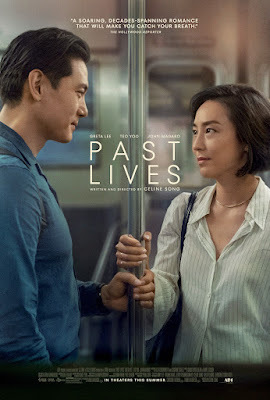
Not long ago I saw on Facebooktwo brothers exchanging their views on Celine Song’s 2023 indie film, PastLives. Both brothers are successful writers, and I worked with one of them(Hi, Lee Goldberg!) in my Roger Corman days. Lee’s brother, Todd, was praisingto the skies Song’s writing and directing debut. Many of his friends (both maleand female) agreed with him, calling it one of the year’s best, and describinghow the ending had them in tears. Lee countered,though, that he had found Past Lives extremely dull. For which he wasaccused by brother Todd of having no heart.
I don’t know about Lee’s lackof a heart, but I’m basically on his side. Not that I found Past Lives boring,exactly. But for me it was remarkably unmemorable, a small and sensitive movieabout people I could barely recall once the lights came up. This story of athirty-six-year-old man who travels from Seoul, Korea to New York City to reunite with the young womanwho won his heart when they were both 12 sounds interesting enough, especiallybecause she’s now married to a loving, and lovable, Caucasian American. And Iwas pleased that, for a change, the emotions in the film were low-key, with noneof the characters on the brink of committing mayhem when they couldn’t gettheir heart’s desire. I like the internationalism of the concept, and (assomeone with experience living in Asia) I’m always pleased to see that part ofthe world recognized on screen.
Still, I was and still amsurprised at the ecstatic reaction that Past Lives has garnered. I cansee it as a Sundance success, but I’ve been stunned at how often it shows upthese days on Top Ten lists. As of Tuesday morning, it is now officially one often films up for a Best Picture Oscar, along with such masterworks as Oppenheimand Killers of the Flower Moon. Radio commentators were lamenting onTuesday that Celine Song was not included by Oscar voters as one of the year’sfive best directors. (Hey, I’m more concerned about the snub to Barbie’sGreta Gerwig.) I doubt Song herself is much lamenting her omission, because shealso authored the Oscar-nominated original screenplay. Several commentatorsalso seem a bit bummed that lead actors Greta Lee and Teo Yoo were overlookedby the Academy. (I’m more inclined to regret the omission of Margot Robbie andWillem Dafoe.)
Don’t get me wrong—I likesmall, sensitive movies. And it’s nice to applaud female writer/directors (especially women of color) who do somethinggood their first time out. But I also understand why the big prizes generallygo to those connected with ambitious projects, films that try somethingbrand-new and gutsy. (That’s why I’m pleased with all the acclaim for PoorThings.) I also tend to root for projects that have something highly importantto say. (That’s why my very favorite film of the year is Killers of theFlower Moon.) I guess Past Lives has taken the “sensitive indie”slot on the Oscar Best Picture list. Good for Celine Song and her team! What Ireally want to see, though, is what she does hereafter.
Not that everyone who wins anOscar needs to be a Hollywood veteran. There’s room for the occasional dazzlingnewcomer, especially when theirachievement strikes a chord with national and international audiences. (Yes,I’m thinking of Lily Gladstone.) But I’m not a fan of overpraising good, modest work, and I believe that whenprizes are handed out, a track record should count for something.
January 22, 2024
A Water Nymph Makes a Splash in “Nyad”
 In Nyad, you’ve got togive Annette Bening credit for having courage. Not simply the courage toportray long-distance ocean swims that showcase her exhaustion, her nausea, andher multiple near-death experiences. But also, as an actress in her latesixties, the courage to spend most of the movie’s run-time decked out in aform-fitting tank suit. Most women, including me, would at a certain point intheir lives rather not be photographed in swimming attire. And this film ishardly an Esther Williams-type extravaganza with a focus on glamour (andwaterproof mascara). This is the real-life story (though some have quibbledabout the details) of an champion distance swimmer who—having failed to swimfrom Cuba to Key West at about age 30, decided at sixty to try again. Itsometimes feels like a stroke-by-stroke recap of her four failed attempts andher final 2013 victory over the waves,the sharks, the jellyfish, and her own mind. (By the end, WE’RE exhausted.) Nyadis also a character study of a woman who is almost brutal in herdetermination to sacrifice everything in order to meet her goal.
In Nyad, you’ve got togive Annette Bening credit for having courage. Not simply the courage toportray long-distance ocean swims that showcase her exhaustion, her nausea, andher multiple near-death experiences. But also, as an actress in her latesixties, the courage to spend most of the movie’s run-time decked out in aform-fitting tank suit. Most women, including me, would at a certain point intheir lives rather not be photographed in swimming attire. And this film ishardly an Esther Williams-type extravaganza with a focus on glamour (andwaterproof mascara). This is the real-life story (though some have quibbledabout the details) of an champion distance swimmer who—having failed to swimfrom Cuba to Key West at about age 30, decided at sixty to try again. Itsometimes feels like a stroke-by-stroke recap of her four failed attempts andher final 2013 victory over the waves,the sharks, the jellyfish, and her own mind. (By the end, WE’RE exhausted.) Nyadis also a character study of a woman who is almost brutal in herdetermination to sacrifice everything in order to meet her goal.Diana Nyad, as portrayed inthis film, is not often gracious. So single-minded is she that she risksalienating even those who love her best and admire her most. The #1 person onthat list is Bonnie Stoll, a racquetball champ who years ago dated Nyadbriefly. As a strongly competitive athlete with organizational skills and atender heart, she’s the ideal coach for Nyad, though at times she’s fullydetermined to walk away from what seems like a foolhardy gamble. Jody Fosterpours her heart and soul into the role of Bonnie, which has made her a nomineefor multiple best-supporting actress awards. Without her feisty but tenderperformance, we might well find Nyad (and Nyad) insufferable. Welshactor Rhys Ifans is also memorable as an old salt whose grasp of Caribbeanwaves and weather makes that final victory possible. Though Nyad is a creatureof towering ego, it’s worth noting that when she lands on that Key West beach,to be greeted by cheering throngs, she speaks of her achievement not as a solovictory but in terms of the “family” of support people who made it possible.
It's an interesting film,though certainly not always an enjoyable one. Uplifting? Maybe, but I mostlycame away relieved that no one was requiring me to go on a long-distance oceanswim anytime soon. And I need to point out some artistic distractions, like thefrequent cutting away to childhood Nyad experiences (some of them disturbing,and not particularly well played) and also the insertion of footage from timeto time of the actual Diana Nyad, who’s still very much around, pursuing acomfortable dry-land career as a radio and TV sports journalist. I also admit,from my spot on the couch, that watching Nyad give it her all, was probably agood reminder to work a bit harder at my local gym.
I’ve always admired Bening asa courageous actress. I first became aware of her in 1990’a The Grifters,in which she held her own as a con artist opposite Anjelica Huston and JohnCusack. She also, in a startling moment, appeared jaybird-naked, another kindof courage. That let to her first Oscar nomination (in support). There’ve alsobeen three Best Actress nominations for such strong films as AmericanBeauty, Being Julia, and The Kids are All Right, but never(alas) a win.
A long, strong marriage toformer playboy Warren Beatty is a win of sorts, though.
January 19, 2024
Facts About American Fiction
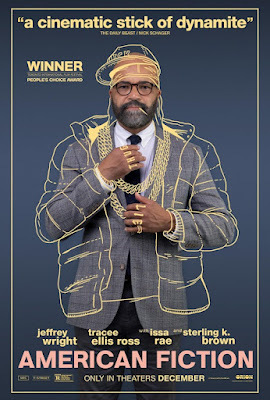
American Fiction nabbed the People’s Choice Award at the 2023 TorontoFilm Festival. I wasn’t there, but I would probably have voted for it too.After all, the film—by writer-director Cord Jefferson in an assured cinematicdebut—touches with sardonic glee on several subjects all too familiar to me,including academia and the wonderful world of book publishing. But AmericanFiction is also much concerned with racial matters, and with the delicate questionof who is entitled to tell whose stories. I can’t pretend to appreciate, as anoutsider, what it’s like to be a Black intellectual in today’s America. But forme American Fiction is a prime example of how to make a funny but pithysmall movie (the kind Alexander Payne does so well), while also weighing in onimportant matters of today. Timely? You bet.
Thelonious "Monk"Ellison, PhD (an unforgettable Jeffrey Wright) isn’t doing so hot. At theCalifornia university where he teaches English and creative writing, a whitestudent berates him for assigning a Flannery O’Connor short story with then-word in its title. The self-righteousness of this generation of students, itseems, is wearing him down. His fellow faculty members don’t show much sympathyfor his unwanted position as the campus point-person for all things Black, butdo remind him that he hasn’t published a new novel in years. (A scholarly andself-contained man, he tends to write lyrical books with allusions to themythology of the ancient Greeks. Being cutting-edge hardly interests him.)Because he has an upcoming trip to the east coast to help judge a literarycompetition, he reluctantly accepts his colleagues’ strong suggestion that hetake a leave and spend time with family.
Ellison’s family members arenot his favorite family. I won’t go into detail and spoil plot surprises, butthey’re a fractured bunch, full of grudges and resentments. They are, though,impressively well educated. His late father was a medical doctor, as are histwo (very complicated) siblings. They live well, spending time at a wonderfulold summer place at the New England shore. Their Black heritage is important tothem, philosophically speaking, but there’s no way they feel much personalconnection to the whole ghetto experience. In the course of his stay, Monkvisits his literary agent, only to discover that no one wants to publish hislatest manuscript. He is, he discovers, just not “Black” enough to satisfyeditors looking for the next best-seller. That’s when an evil impulse strikeshim, and he begins to write—at white heat, one might say—a raw, ragingnarrative full of every cliché (guns! drugs! bad grammar!) of inner-cityAfrican-American life. Pretty soon he’s facing an unexpected dilemma: how doeshe turn down a small fortune in advances and the sale of movie rights for anovel he doesn’t want to claim as his? (His literary agent certainly hassomething to say about the choice he ends up making.)
The plot thickens as Monk takes on family responsibilities, finds (maybe!)love, and—as part of his work on the committee judging contemporary literaryexcellence—runs into opposing views that get him (and us) thinking. (I’m stillchewing on the position taken by the one other person of color in the group.)If all of this seems solemn, fear not. Hollywood (in all senses) basicallysaves the day. American Fiction builds to a truly hilarious conclusion,a moment that in one fell swoop lampoons all of the film’s satirical targets.And then sends us to the exits in a marvelous mood.
January 16, 2024
(Jack) Ruby on Tuesday
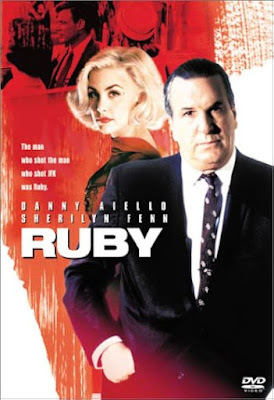 My colleague Danny Fingerothhas had a full career that includes a long stint as editor of the Spider-Mancomics line for Marvel Comics. He’s also a writer, having produced several volumeson Stan Lee and his Marvel-ous Universe. But Danny’s most recent publicationleaves the comic book world behind, as he takes on a long-time fascination withJack Ruby, the man who shot Lee Harvey Oswald on national television, therebyupending the American justice system and prompting decades of conspiracytheories to flourish.
My colleague Danny Fingerothhas had a full career that includes a long stint as editor of the Spider-Mancomics line for Marvel Comics. He’s also a writer, having produced several volumeson Stan Lee and his Marvel-ous Universe. But Danny’s most recent publicationleaves the comic book world behind, as he takes on a long-time fascination withJack Ruby, the man who shot Lee Harvey Oswald on national television, therebyupending the American justice system and prompting decades of conspiracytheories to flourish. Danny seems to knoweverything there is to know about Ruby, his family, and his sad little life.You can’t fault him for a lack of details, about (for instance) Ruby’s patheticforays into show biz as the owner of a Dallas nightspot. (Danny calls him, witha nod to Arthur Miller, “the Willy Loman of strip-club operators.”) Frankly, all those tidbits about unruly dogsand patrons thrown down staircases can get a bit much. The very strongest partsof his book are its preface and its conclusion. The preface comments sagelyregarding the impact of the JFK assassination and its aftermath on the era’syoung children, like Danny himself. For little boys like him, what washappening on the living-room TV on that Dallas weekend was not so differentfrom what they were used to seeing on the era's popular crime shows, like The Untouchables.
Danny speaks of television,but I was personally struck by the role played by motion pictures in Ruby’sstory. Certainly, he himself was starstruck, and even had showbiz aspirationsvia a nightclub act he promoted, featuring Little Daddy, a song-and-dance kid.Regarding Ruby’s tangled motives to go after Oswald, who was then in policecustody, Danny wonders, “Was he starring in some movie in his head that only hecould see?”
Then too, movies continue to be part of thepublic’s memories of what happened on a Dallas weekend in November 1963. LeeHarvey Oswald, President John F. Kennedy’s assassin (or was he?) was arrestedby Dallas police while seated in the Texas Theatre, watching a flick called Waris Hell. Then there’s the infamous Zapruder home-movie footage of theassassination, which has long been studied for the possibility that it explodesthe lone-gunman conclusion of the Warren Commission. And of course we can’tforget all the commercial movies inspired by aspects of the Kennedyassassination, particularly Oliver Stone’s conspiracy-focused JFK (1991).Ruby is portrayed in that film, and Danny’s book ends with a listing of otherplaces that Ruby and his associates have ended up in American pop culture(including a Stephen King bestseller). I had no idea that Danny Aiello starredin a 1992 film, simply called Ruby, which totally falsifies history byturning Oswald’s bungling killer into a slick criminal mastermind. As recentlyas the summer of 2020, the second season of Netflix’s The Umbrella Academyfound itself set in Dallas, circa November 1963, with Ruby (and his beloveddachshunds) prominently—and accurately—pictured.
Even Ruby’s Dallas rabbi,Hillel Silverman, got the showbiz treatment. Silverman, who spent many hourscounseling Ruby in his jail cell before decamping for Los Angeles, playedhimself in a 1978 made-for-TV movie, Ruby and Oswald, directed by StanLee’s cousin, veteran filmmaker Mel Stuart. (Danny thinks the world shouldknow that Rabbi Silverman—having gone Hollywood all the way—produced an actor-son,Jonathan, who starred in Weekend at Bernie's.)
And what is Danny’sconclusion about the importance of this odd and troubled man? “He certainlyimpacted history, helped change the way we view the very notions of justice andeven our concept of agreed-upon truth. Whether he was a lone nut or part of a conspiracy,the repercussions of his actions will be with us forever.”
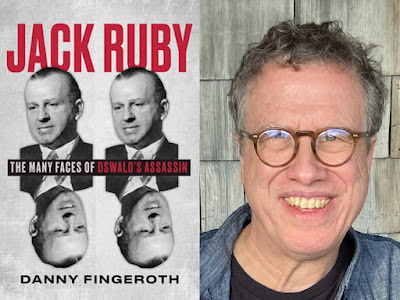 Danny Fingeroth and his book
Danny Fingeroth and his bookJanuary 12, 2024
May December : The Crashing of Symbols

The old song says it: “It’s along, long while from May to December.” As a film about the consequences oflong-ago horrific behavior, May December sounds more interesting than itis. As a Todd Haynes project featuring two of Hollywood’s boldest actresses, MayDecember is most surprising in that it’s a male character (and a relative Hollywood newcomer) who largelycaptures our attention. The premise is intriguing: an older woman (JulianneMoore) once shocked the nation with a series of horrific acts, which involved asexual relationship with a thirteen-year-old boy, whom she later (following ajail term and the birth of a baby while incarcerated) married. Into hersmall-town domestic life, some two decades after all this sturm und drang,comes an ambitious young actress (Natalie Portman) who’s planning to star in anindie film in which she portrays the female half of the mismatched couple.
I came into the film curious to see how thetwo women would evolve, and how one might influence the other. I’m leavingaside here the question of how a radiant performer like Moore could (at 63,though her character must be slightly younger) represent December. In the film,she’s—from start to finish—a happy housewife, doting on her three kids and herhunky (much younger) husband. Any doubts she might have about the unbalancednature of her marriage to a 36-year-old seem non-existent, from start tofinish. The result: I didn’t much enjoy watching her onscreen. It’s only nearthe very end, when she says something about her troubled older child from aprevious marriage that may or may not be true, that I started to wonder ifthere was more to her character than a placid, rather addled, acceptance of thestatus quo.
I had wondered, too, if thisfilm might be an exploration of merging identities, somewhat in the way thatBibi Andersson’s and Liv Ullmann’s characters seem to coalesce in IngmarBergman’s 1966 Persona. This may be the filmmakers’ goal, but I mostlyremember Portman wandering around Moore’s small town, taking notes as sheunearths character nuggets from Moore’s screen family and friends. Though, as abuttinsky, she’s treated with a surprising amount of courtesy by everyone shemeets, there’s an air of Hollywood fakery about her. This seems confirmedwhen—late in the film—she turns a moment of compassion into somethingdifferent, something definitely predatory. And then, at the film’s conclusion,we see her in character, playing Moore’s Gracie in a way that seems to undercutour previous sense that she’s on Gracie’s side.
Writing this, I realize that thefilm sounds quite provocative. But it’s also infernally slow, scored withdoleful music and missing any real spark of life. Both female leads lackedappeal for me; the only character for whom I felt compassion was the younghusband (the critically praised Charles Melton), trapped in a domesticity thatdoesn’t match up with his biological stage in life. He’s the one who has,appropriately, garnered most of the film’s awards this season, for delineatingthe awkward tension between his character’s role as pater familias and a young man’s restless wish to explore thewider world. Still, his hobby of tending the cocoons of monarch butterflies isso obviously meant to be symbolic of his own personal needs that it quicklybecomes irksome.
The story of May December isclearly based on the long-ago case of Mary Kay Letourneau and her much-underageparamour, Vili Fualaau. An L.A, Times columnist notes that Fualaau, still aliveat 41, wishes the world would stay away from his tricky story.

January 9, 2024
Send In Glynis Johns (A Heartfelt Send-Off)
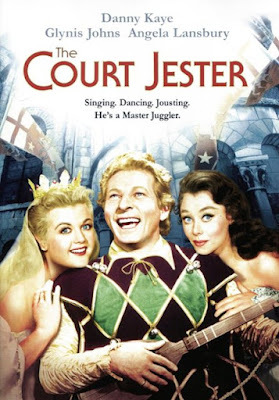
The headlines announcing thedeath of actress Glynis Johns at the ripe old age of 100 tended to focus on her1964 appearance as Mrs. Banks (both a mom and a daffy suffragette) in Disney’smega-musical, Mary Poppins. Sevcral newspapers, notably the New YorkTimes, spotlighted her as a Tony-winner for her 1973 role in StephenSondheim’s A Little Night Music, in which she introduced the poignant“Send in the Clowns.” But her stage and screen successes started early. Comingfrom a long line of performers on both sides of the family, she made herBritish stage debut at age 12. In 1936, she played the trouble-makingschoolgirl at the heart of Lillian Hellman’s bold-for-its-time TheChildren’s Hour. Her move into movies came in 1938: film brought her rolesthat were both dramatic and comedic. By 1949 she was starring in a Britishfantasy called Miranda that today sounds uncannily like the TomHanks-Daryl Hannah 1984 romance, Splash. Playinga mermaid who comes ashore to see London, she was highly praised by New Yorkcritic Bosley Crowther, who gushed, “Glynis Johns is bewitching — one half ofher is, at least — as the coyly flirtatious finny creature.”
She made her Hollywood screendebut circa 1950, again being cast in a wide variety of roles. Though comedy washer forte, she was Oscar-nominated as a talkative innkeeper in a major 1960drama set in the Australian Outback, The Sundowners. My own first screenencounter with Johns came when I was a small girl delighting in Danny Kaye’sfunniest movie, The Court Jester (1955). This is a mock-medieval romancein which Kaye’s meek character is persuaded to masquerade as the king’s jesterin order to overthrow a usurper to England’s royal throne. The film isenlivened by hilarious wordplay I can still recite (“The pellet with thepoison's in the vessel with the pestle,” and so on). There’s also some wackyjousting and an unforgettable sword-fight in which Kaye’s character, duelingthe great Basil Rathbone in his final onscreen bout, swerves madly back andforth between timid and bold,
In the Court Jester thereare two important female characters. Angela Lansbury plays Gwendolyn, animperious English princess with eyes for the jester. Johns is Maid Jean, one ofthe rebels dedicated to removing the usurper from the throne. As a small girl,I was confused. Jean seemed both bold and smart, admirable qualities, to besure. And she had a wonderful throaty speaking voice I instinctively liked. YetGwendolyn was a princess, and (more than that) a tall blonde. So familiar was Iwith the social norms of the era that I figured she’d be the one who’d end upwith the guy. Happily, though, it turns out to be the short(er) brunette whogets her man. Here, for a change, was a case in which blondes don’t have morefun.
Some twenty years later,Johns IS a blonde, and she too is apparently unlucky in love. (In real life,she was married and divorced four times.) On-stage, in A Little Night Music,she originated the role of Desiree Armfeldt, a celebrated stage actress whosemultiple romantic affairs never pave the way for a permanent union with the oneman she wants. In compensation, she gets perhaps the most memorable song in theSondheim canon, a rueful acknowledgment of where her life has led. It waswritten in a limited range to accommodate Johns’ modest vocal powers whilegiving her a chance to convey strong emotion. Though many famous singers haverecorded it, Sondheim insisted that Johns’ original version was his veryfavorite.
January 5, 2024
I Left My Arts in San Francisco
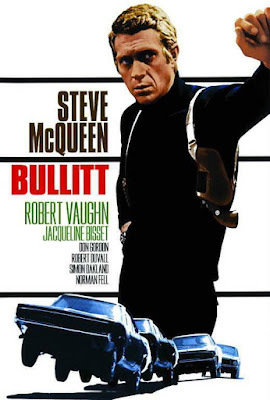
Yes, it’s a not-very-goodjoke. But, newly returned from the Cityby the Bay, I can’t resist pointing outSan Francisco’s cultural riches, which include world-class art museums, a longtradition of support for the local symphony and opera company, and such uniquevenues as the Mechanics’ Institute Library.The latter is a private cultural center, founded back in 1854, that can bejoined by anyone who purchases a membership. Located in San Francisco’sbusiness district, it is particularly proud of its chess room and frequentchess tournaments. There’s also a lively interest in film. My colleague MatthewKennedy (whose upcoming book for Oxford University Press is On ElizabethTaylor: An Opinionated Guide) curates CinemaLit, a monthly array of themedfilm-related events housed at the institute. At the moment, he’s expanding onthe intersection of chess and cinema by offering a series called “Chess in theMovies.” A chess coach will join him tonight, January 5, for a screening of1983’s terrific Searching for Bobby Fischer. The Thomas Crown Affair,with its sexy chess game between Steve McQueen and Faye Dunaway, shows up laterin January.
The first time I ever visitedSan Francisco, as a young teen from L.A., my family and I happened upon a filmcrew shooting a dramatic night scene outside a San Francisco walk-up. We wereamused that we’d left SoCal, only to find that Hollywood had come to us. Themovie was Experiment in Terror, and I know little about it, other thanthat it starred Lee Remick and Steve McQueen. As the title says, it was athriller—and I’m sure the steep streets and dark alleys of the city added towhat scares there were in the script. McQueen of course starred far morememorably in another San Francisco movie. Bullitt (1968), with McQueenplaying a tough but non-conformist cop, took full advantage of the city’stopography, staging a breath-taking car chase up into the hills.
The Sixties, of course, wasan era marked by youthful rebellion against the status quo, and San Franciscowas ground zero for stories of young runaways who came to the city’s Summer ofLove to get their groove on. There’s only a tiny glimpse of San Francisco in onof 1967’s hugest hits, The Graduate: SoCal’s Benjamin Braddock—who findsonly monkey mockery at the San Francisco Zoo—will pursue love and liberationfrom parental expectations mostly across the Bay Bridge, in collegiate Berkeley.But more typical of the era’s youth movies is a genre flick called Psych-Out(1968), from Dick Clark Productions (!) and the low-budget mavens atAmerican International Pictures. There’s this deaf girl played by SusanStrasberg who comes to Haight-Ashbury in search of her brother. Of course sheencounters lots of hippies (Dean Stockwell, Jack Nicholson), as well as amysterious stoner (Bruce Dern in a really bad wig) whose delusions lead todisaster for all.
As the Sixties gave way tothe Seventies, some filmmakers thought of San Francisco as the perfect place toset a madcap romp. Peter Bogdanovich, riding high after The Last PictureShow, teamed big stars Barbra Streisand and Ryan O’Neal in a Bringing UpBaby-type story about a kook and a stuffy professor who are galvanized bythe mix-up of four identical pieces of luggage with wildly differing contents.The high-speed chase involving a stolengrocery store delivery bicycle and a plunge into the bay was intended, I’vediscovered, as a wacky homage to Bullitt. (The film ends with a cheekyreference to O’Neal’s recent mega-hit, Love Story.
Adieu, Ryan O’Neal! More SanFrancisco movies yet to come, along with a salute to the late Glynis Johns!

January 2, 2024
Poor Things: Barbie Goes Victorian

You’ve heard of Dr.Frankenstein, who created a monster out of bits and pieces of human beings. Andyou’ve heard of Pygmalion, the ancient Greek who sculpted a beautiful woman andthen fell in love with her. (The story was modernized by George Bernard Shaw,author of a play about linguist Henry Higgins, who turns a cockney flower girlinto a duchess by teaching her how to speak the King’s English. Of course,Shaw’s play became a beloved romantic musical, My Fair Lady, in whichconfirmed bachelor Higgins and former flower-seller Eliza Doolittle cometogether in the finale.)
I mention all of the abovebecause a current hit film, Poor Things, combines elements of theFrankenstein monster with Pygmalion’s beloved Galatea. The pieced-togetherwoman who develops into an unlikely love object first shows up in this film as achildlike innocent who can barely speak, and walks with an unsteady gait. Theodd and fascinating details behind her creation are something you won’t hearfrom me. Suffice it to say that she calls her much-disfigured patron “God” (hisname is Dr. Godwin Baxter), and that initially she clings to his every word.But her boundless appetite for life leads her to discover corners of theworld—and her own body—she was not anticipating. So she’s off on a series of eroticadventures in the various capitals of Victorian Europe, portrayed via YorgosLanthimos’ highly original filmmaking as the most charming of stage sets.(Lanthimos seems to share with Wes Anderson a passion for fanciful artdirection, but I’m convinced Lanthimos, who previously released The Lobster andThe Favourite, has much more to say.)
It's easy enough to call PoorThings kinky. Certainly it’s full of sexual couplings, blunt language, andbody-revealing costumes (and the lack thereof). We certainly see a great dealof Emma Stone, who—in the innocent-abroad role of Bella Baxter—discovers boththe joys and the humiliations of sex. It’s fun to remember that Stone, aproducer as well as the star of this film, made her breakthrough in 2010’s EasyA. There she played the bravura role of a smart, nerdy (and virginal) teen whopretends to be the local tramp as a way to navigate the rigid social scene ather high school. In Poor Things, the “tramp” label would have no meaningfor Bella. Totally committed to satisfying her own wants and needs, she judgesthe behavior of others in terms of the level of satisfaction they bring to her.Still, she’s constantly evolving, learning that the bed-jumping that had sodelighted her in the arms of the roguish Duncan Wedderburn (a slimy MarkRuffalo) is not always the route to personal satisfaction.
Bella’s path turns out to befull of men who want to control her. There is, first of all, her “creator,” theobsessive scientist eerily played by Willem Dafoe. There is Wedderburn, asexual libertine who finds the tables turned when he falls for Bella. There’sanother man who emerges late in the film, and seems to have the means to bendher to his will. All these can be said, by final fadeout, to be among the “poorthings” to which the title refers. Men don’t fare well in this film, exceptperhaps for Max (Ramy Youssef), the gentle science nerd who loves Bella forherself.
Poor Things is a triumph ofcinematography, musical scoring, set design, and the melding of past and present.Bella Baxter is a heroine for today, a Barbie who has taken a different (butparallel) route to self-realization.
December 29, 2023
Fiddling Around with “Chevalier”
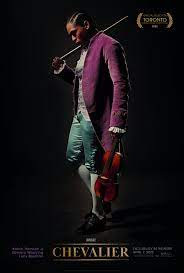
Many of today’s storytellersseem to be trying hard to make amends for historical oversights. See TV’spopular Bridgerton, which whimsically insists (based on somedubious historical rumors) that QueenCharlotte, consort of George III, was of Black African descent.
I never saw Belle, the2013 British drama, which embroiders the details of the actual life of aneighteenth-century young woman. History says she was welcomed into thehousehold of an English aristocrat because she was the mixed-race daughter ofhis nephew and an enslaved African woman living in the Wests Indies. We knowabout Belle through a 1779 painting, commissioned by the First Earl ofMansfield, showing her and his own daughter as well-dressed youthfulcompanions. But few details of her adult life are available, and so thefilmmakers were free to invent a story that coincides with Britain’s 1807abolition of the slave trade.
Then there’s the fascinating2022 film, Chevalier, about an 18th century musician who becamea major figure in his own day. Joseph Bologne, who was later granted the titleChevalier de Saint-Georges, was born in Guadeloupe, the son of a French planterand a 17-year-old slave of African descent. An unusually gifted child, Joseph wassent to France to be educated, excelling in fencing, shooting, horsemanship,and above all music. A violinist from an early age, he developed a great deal of confidence in histalents. (The film shows him, as a young man, interrupting a concerto performedby the visiting Wolfgang Amadeus Mozart in order to suggest that the two performthe piece side by side, in a kind of classical fiddle-off. Which they do, withdazzling results.)_
Among the aristocracy of 18thcentury France, Bologne was alternately viewed as a genius and a fraud, an“upstart Mulatto” and something of a sex symbol. At least, he was a greatfavorite of Queen Marie Antoinette, who attended many performances of his work.By this time, he was busily composing violin sonatas, chamber pieces,symphonies concertantes, and comic operas, sometimes for his own orchestras,while also taking time out to defeat local fencing masters who had sneered athis racial heritage. In 1776, he lost the prestigious post of orchestra conductorat the Paris Opera when some of the players refused to perform under hisdirection.
I gather the historicalrecord has little to say about his love life. Not surprisingly, the movie makesup for this omission. Though Bologne (rising American actor Kelvin HarrisonJr.) is handsome and hunky, it is made clear that he’s resigned to never marrying.As we’re told, his marriage to a white woman would have then been illegal underFrench law. And if he were to wed a Black woman, he’d have to forfeit hismuch-prized title. That doesn’t stop him, though, from having a torrid affairwith a beautiful and talented aristocrat (Samara Weaving), whose powerfulhusband doesn’t want her singing in public. Alas, it doesn’t end well.
The film fades out, circa1789. as revolutionary forces arise to take on the power of the Frenchmonarchy. Bologne, who has learned (partly through his spirited mother) tovalue the Black side of his inheritance, has a small moment of triumph, onethat’s probably too theatrical to be true. But we do know, via an on-screenlegend, that he went on to serve as a colonel in the Légion St.-Georges, comprised of “citizensof color” fighting in opposition to the Bourbon status quo. There was clearly alot more to his life than was seen in the movie. Maybe there’s a plan for asequel?
December 26, 2023
The Rashomon Mishmash that is “Les Girls”
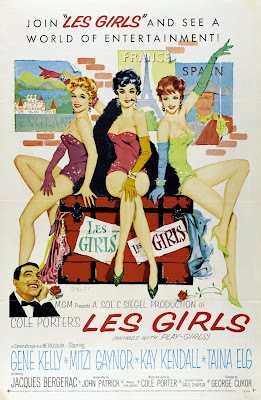
Which Hollywood film borrowssomething from Akira Kurosawa’s groundbreaking Rashomon and somethingfrom Marlon Brando’s biker persona in The Wild One? Give up? It’s an MGMmusical comedy from 1957, titled Les Girls.
As a longtime fan of bright,splashy Hollywood musicals, I looked forward to seeing a film directed byGeorge Cukor, scored by Cole Porter, and starring Gene Kelly. Sadly, none oftheir talents are fully on display here. The words and music by Porter (forwhom this was a final motion picture) are totally forgettable. The charm andprecision of Cukor (I just rewatched Adam’s Rib for the umpteenth time)are only a sometime thing. Kelly, about to move on to producing and directing,still looks good and dances well, but he seems in this film to be ageing out ofthe romantic lead category. The three “girls” of the title do each have theirmoments, but the film itself is an odd hybrid of outrageous shenanigans,romantic passion, and musical comedy shtik. Still, it’s not the worst way topass an evening at home on the couch.
The film begins in a London courtroom, withone very posh matron suing another for libel. It seems Sybil (now Lady Wren)has published a tell-all memoir of her years in a cabaret performance troupe.In her best-seller she has detailed the suicide attempt of Angele, one of herdance colleagues, when a passionate romance went awry. Cut to Paris, where youngerversions of the elegant British Sybil (Kay Kendall) and the perky American Joy(Mitzi Gaynor) are featured in a popular stage revue led by Barry Nichols (GeneKelly). They are quickly joined, both on-stage and in a not-too-shabby Parisapartment, by a new recruit, the flirtatious French Angele (Taina Elg). Angelehas a devoted French suitor back home in the provinces, but she is all tooquick to make the moves on Barry, who responds with enthusiasm. Disasterstrikes when Angele’s provincial (but hugely wealthy) fiancé shows up with hisparents, thinking she’s in the nation’s capital to study nursing. She panics,ruins the evening’s performance, as well as—apparently—her romantic future onboth fronts. Sadly, suicide seems the only way out, but she’s rescued just intime.
Back in the Britishcourtroom, we now get Angele’s testimony, which exonerates her completely whileflashing back to Sybil’s (hilarious) drunken antics in that Paris apartment.Her condition prompts fisticuffs between the supportive Barry and Sybil’s ownlongtime suitor, a starchy British lord. Kendall’s uproarious tipsiness in thissection reminds us what a boon she was to the entertainment world before herall-too-early death at age 37. The flashback ends with an account of a suicideattempt not by Angele but by Sybil herself.
On Day 3 of the trial, Barryhimself shows up as a surprise witness. In HIS version (this is how the Rashomonanalogy fits in), neither Sybil nor Angele successfully captured hisromantic attention. And the suicide attempts in each woman’s courtroom storyhave a very different explanation, which winds up ending the trial with goodwill restored all around. Or is it?
How does Marlon Brando fitinto all this? There are, of course, a number of dance numbers in the film, allchoreographed by Hollywood legend Jack Cole. Some are lurid, one tries hard tobe risqué, all are well danced. But the best of them features Kelly and MitziGaynor. She’s a lovelorn café proprietor; he’s a biker (like Brando’s Johnny) witha black leather jacket and a gang of henchmen. Things quickly get steamy:definitely worth the price of admission.
Beverly in Movieland
- Beverly Gray's profile
- 10 followers



